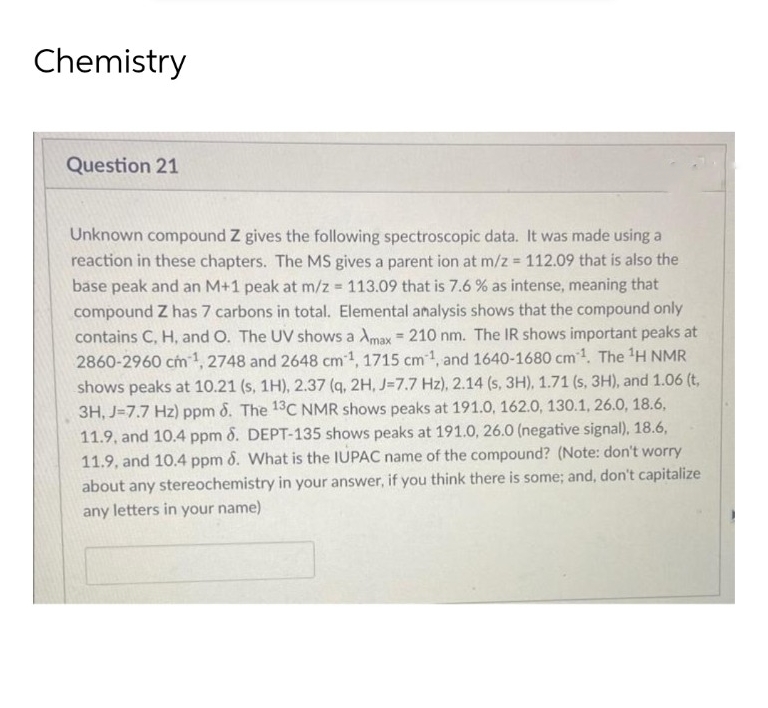= Unknown compound Z gives the following spectroscopic data. It was made using a reaction in these chapters. The MS gives a parent ion at m/z = 112.09 that is also the base peak and an M+1 peak at m/z = 113.09 that is 7.6% as intense, meaning that compound Z has 7 carbons in total. Elemental analysis shows that the compound only contains C, H, and O. The UV shows a Amax 210 nm. The IR shows important peaks at 2860-2960 cm ¹, 2748 and 2648 cm 1, 1715 cm 1, and 1640-1680 cm ¹. The ¹H NMR shows peaks at 10.21 (s, 1H), 2.37 (q, 2H, J-7.7 Hz), 2.14 (s, 3H), 1.71 (s, 3H), and 1.06 (t. 3H, J-7.7 Hz) ppm 8. The 13C NMR shows peaks at 191.0, 162.0, 130.1, 26.0, 18.6, 11.9, and 10.4 ppm 8. DEPT-135 shows peaks at 191.0, 26.0 (negative signal), 18.6, 11.9, and 10.4 ppm 8. What is the IUPAC name of the compound? (Note: don't worry about any stereochemistry in your answer, if you think there is some; and, don't capitalize any letters in your name)
Analyzing Infrared Spectra
The electromagnetic radiation or frequency is classified into radio-waves, micro-waves, infrared, visible, ultraviolet, X-rays and gamma rays. The infrared spectra emission refers to the portion between the visible and the microwave areas of electromagnetic spectrum. This spectral area is usually divided into three parts, near infrared (14,290 – 4000 cm-1), mid infrared (4000 – 400 cm-1), and far infrared (700 – 200 cm-1), respectively. The number set is the number of the wave (cm-1).
IR Spectrum Of Cyclohexanone
It is the analysis of the structure of cyclohexaone using IR data interpretation.
IR Spectrum Of Anisole
Interpretation of anisole using IR spectrum obtained from IR analysis.
IR Spectroscopy
Infrared (IR) or vibrational spectroscopy is a method used for analyzing the particle's vibratory transformations. This is one of the very popular spectroscopic approaches employed by inorganic as well as organic laboratories because it is helpful in evaluating and distinguishing the frameworks of the molecules. The infra-red spectroscopy process or procedure is carried out using a tool called an infrared spectrometer to obtain an infrared spectral (or spectrophotometer).

Step by step
Solved in 5 steps with 5 images




